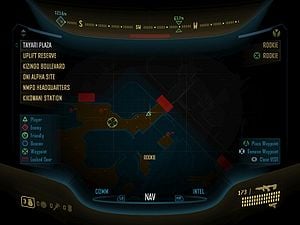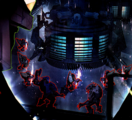Visual Intelligence System, Reconnaissance
From Halopedia, the Halo wiki
- "It's simple: If you see green, squad up. If you see red, shoot."
- — Urk, Bungie.net.[1]
The Visual Intelligence System, Reconnaissance, abbreviated as VISR, is a proprietary integrated data management system incorporated into the helmets of Orbital Drop Shock Troopers.
Overview
The VISR provides tactical data in real time as it is broadcast, and can link into UEG, CAA and UNSC infrastructure systems at the local, national, and global network levels, administered on a need or rating basis, allowing the user to store and review up to 610MB of content relevant to the current or all mission objectives.
The VISR also provides navigational data, various points of interest in the area, and other important functions. It also includes low-light vision enhancement systems as part of ODST BIOS update A29.817941B.01, this raising the brightness of the surrounding area on the user's heads-up display during night time operations. The VISRs low light vision enhancement also links with the users neural interface to provide Friend or Foe designation by searching for IFF Transponders on friendly or enemy infantry.
Enemy and friendly infantry, weapons and objects are highlighted with different colors. "Friendly" combatants are highlighted in green, "enemy" combatants are highlighted in red, usable weapons, vehicles and health packs are highlighted in blue, other objects, scenery and buildings are highlighted in orange, beacons and data terminals are highlighted in bright yellow.[2]
The core technology of the VISR system was originally developed for the MJOLNIR Powered Assault Armor[3] and was field tested by SPARTAN-III Headhunter teams.[4] Unlike the visual interface system developed for the Spartans, the ODST VISR requires no neural interface.[3]
Advantages
The VISR as a data management suite provides an ODST with the best tactical data in the field. Data uplinks and the ability to tap into infrastructure systems, or access an AI to acquire information makes the VISR a valuable tool for Helljumpers in combat. The VISR can connect to any network broadcasting a wireless signal, like a local, or planetary network, or an orbiting satellite like the STARS. This ability to connect to any accessible network allows the VISR to quickly and intelligently search, access, and broadcast data relevant to the current mission objective quickly.
Disadvantages
The VISR's main disadvantage is its low vision enhancement feature, which cannot function in day time-lighting situations. The VISR's different functions cannot be toggled seperately such that only the identification-highlighting functionality is active. This limits the true potential of the system, as it could identify both potential targets not at first noticeable to the soldier, and objects of interest that may be relevant to the current objective. The VISR's data management and GPS functionality also cannot be accessed when in a combat zone, as they obscure the user's view of the battlefield.
VISR Database
The VISR database holds pertinent and relative information concerning battle to provide a distinct tactical advantage to the wearer.[notes 1] The database encompasses three main parameters situated in a carousel formation:
- NAV - Shortened for "Navigation", this tab is self-explanatory. As ODSTs lack a motion sensor in their HUD, the NAV component in the VISR database provides a far more dynamic integration of mapping systems than featured by a standard motion tracker. It is very similar to the TACMAP in all MJOLNIR suits.[notes 2][notes 3] The NAV tab is possibly the most useful feature in the VISR database suite because it provides a complete bird's-eye view of the current area in a interactive schematic grid, and, more importantly, the NAV parameter also shows the enemy forces in their entirety within the proximity of the highlighted area. This property of the database makes it very useful for tactical situations where planning is a key element. One downside to the enemy position interface is that the NAV function does not identify the enemies individually (such as by rank or species, etc.) -- they are all represented with the same red diamond. However, one may still discern which types of Covenant infantry are in the vicinity by the marker's relative movement speed. Additionally, the NAV function will only preview enemy locations within the vicinity of the VISR operator.[notes 4] Storage caches are also marked on the NAV screen as green icons depicting the Superintendent, and can be marked via a waypoint (a marker that can be placed only once at a time that uploads the location to the user's compass). The compass is synced with this parameter of the VISR database, as waypoints and beacons show up as integrated icons within the direction in relation to their location.
- INTEL - Short for "Intelligence", this parameter is a comprehensive multi-listing of the current mission objectives. On the right-hand side, a picture depicting the user is shown along with a symbol denoting rank, as well as the name of the operator. Another useful feature of this component is to set a marker to the current objective location along with a brief description of what the objective entails. Both the description and marker are broadcasted upon the HUD of the user, but the "hint" marker (which is an orange icon depicting the Superintendent) is not synced to the compass like the NAV data for beacons and waypoints. Beacons often represent the current objectives, and sometimes a beacon can have the same location that a "hint" marker does, allowing a user to still see a quick view of the objective location without having to view the database.
- COMM - This component of the database system is short for "Communications". It is rather simplistic in its design and function.[notes 5]
There are other elements (some are mentioned above) that are encompassed within the VISR database:[5]
- Compass (Integral with all factors regarding location, designation, and direction)
- Key Locations (Preplaced Beacons--Mission Objectives)
- Map Legend (Shown for all map elements)
- Grenade Inventory (Integrated with the HUD)
- VISR Database Tabs (The carousel formation--pressing RB and LB rotates the carousel)
- Weapons and Ammunition (Integrated with the HUD)
- Controller Legend (Specific button-mapped functions)
- Waypoint List
- Map of New Mombasa (Interactive map schematic)
Trivia
- On the left-hand side in the INTEL feature within VISR, the current location is listed along with a seemingly-hidden Marathon symbol that is behind the "Triplicate" emblem.
- The VISR map display also marks hostile units in and around the player's location, possibly thanks to the Superintendent. This may be hinted at during one of the audio logs in game, where Sadie suggests to Dr. Endesha that he should reprogram Vergil to identify Covenant troop types, which he agrees to do.
- When VISR is activated, Huragok writings are highlighted on walls around New Mombasa. They appear to be Covenant or Forerunner symbols. They commonly appear around dead Sangheili.
- The navigational database system in the VISR is similar to the TACMAP in both SPI and MJOLNIR armor systems.
- Anything using active camouflage (specifically, Brute Stalkers) will be highlighted in orange by the VISR. This means that the system identifies cloaked objects as scenery.
Gallery
VISR mode seen in Halo: Helljumper.
List of appearances
- Halo 3: ODST (First appearance)
- Halo: Evolutions - Essential Tales of the Halo Universe
- The Reclaimer Trilogy
Notes
- ^ The VISR data management suite can be accessed by pressing the back button at any time during Campaign or Firefight play modes in Halo 3: ODST. Aside from the advantages that the database delivers in terms of intelligence and tactics, it has a significant disadvantage; using the VISR database requires one to basically "pause" the game -- however the player can still receive damage while viewing the database, so it is recommended to only view it in a relatively safe area.
- ^ The TACMAP is featured canonically in stories but is absent from gameplay in any Halo game.
- ^ The NAV tab is the only feature from the VISR database in the Firefight game mode, and it is reduced to only show the user, allies, and enemies on the map's integrated screen and legend.
- ^ The system can also review any previously visited area of the city, however enemies can only be seen in the current area: player can not see enemies that are in Tayari Plaza when player is in, let's say, Uplift Reserve.
- ^ The COMM feature serves as a very effective aid for the audio log achievements (especially Audiophile). The audio transcripts that the Rookie collects along his journey through the city can be reviewed here, and often the transcripts provide backstory to understand what happened to New Mombasa and its citizens, namely Sadie and Vergil. The audio logs also provide a sense of mystery, as they are discovered in any order and deciphering the facts can be confusing if the logs are not collected in a correct order. The element of mystery from the audio logs adds a certain similarity to a neo-noir modern detective story, as players collect clues and try to understand what has happened to the metropolis of New Mombasa. Once all the audio transcripts are collected, the user can then play them all and go through them in a chronological formation rather than reading scattered bits and pieces.
Sources
- ^ Bungie.net: "Feet First" Update
- ^ Bungie.net: Halo 3: ODST Project Page
- ^ a b Halo Waypoint, VISR
- ^ Halo: Evolutions - Essential Tales of the Halo Universe, "Headhunters", page 164
- ^ UNSC Field Operations Guide (Halo 3: ODST Instruction Manual), page 8-9


